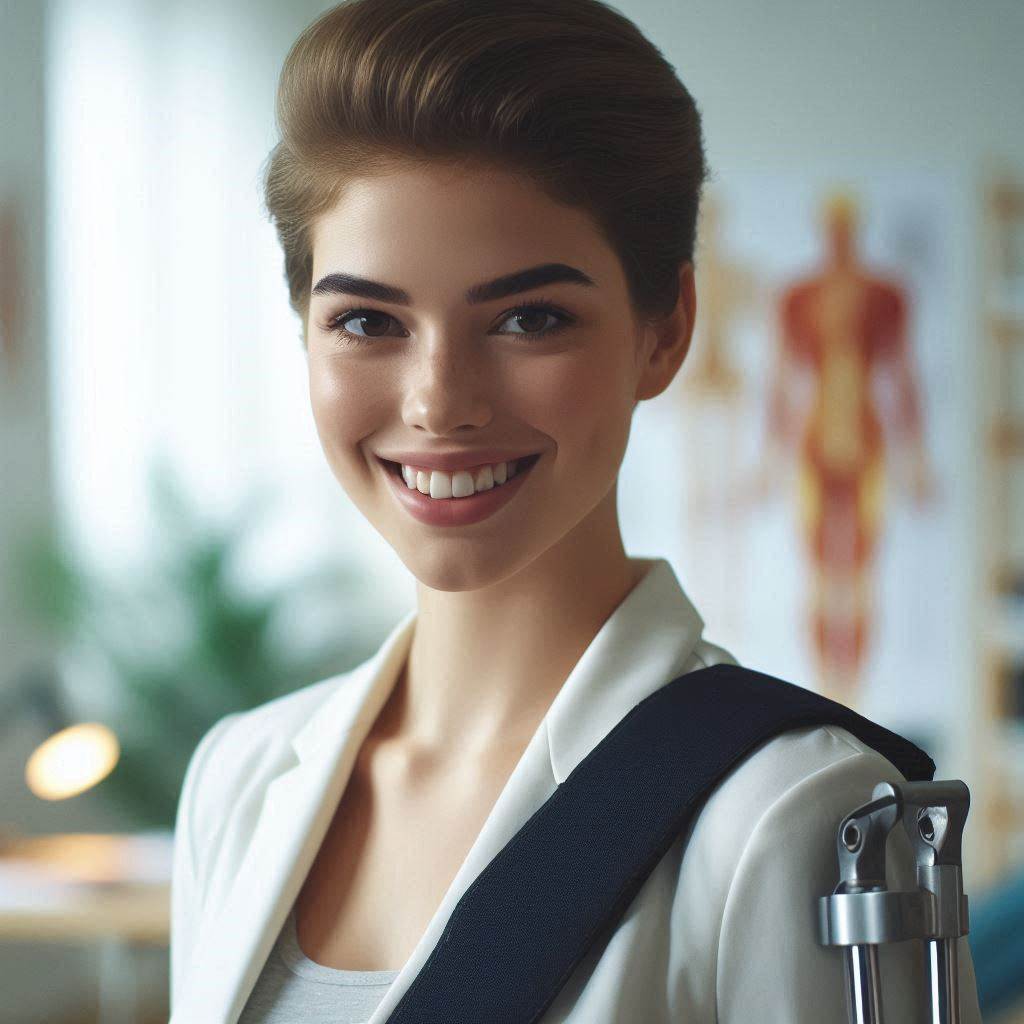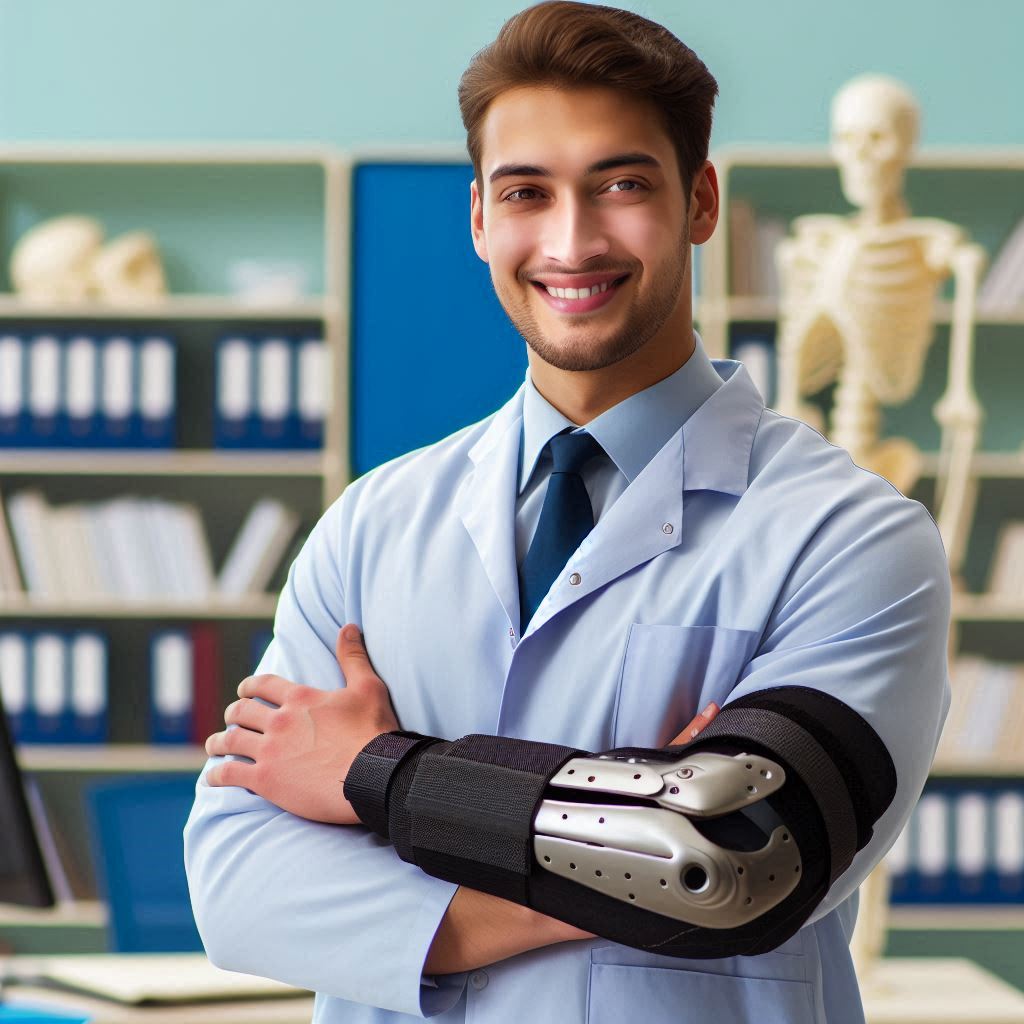Introduction
Sports Medicine and Athletics Orthotist Prosthetist: Orthotists and prosthetists play a pivotal role in sports medicine and athletics, working behind the scenes to help athletes achieve their best performance while preventing and managing injuries.
These specialized healthcare professionals design, fabricate, and fit orthotic devices and prosthetic limbs, tailored to the unique needs of each athlete.
In sports medicine, orthotists focus on creating custom orthotic devices that provide support, correct alignment, and enhance movement efficiency.
These devices include insoles, knee braces, ankle supports, and more, all designed to alleviate pain, prevent injuries, and improve athletic performance.
For athletes with limb loss, prosthetists develop high-performance prosthetic limbs that enable them to compete at elite levels.
The importance of orthotists and prosthetists in sports medicine cannot be overstated.
Their expertise ensures that athletes can maintain peak performance while minimizing the risk of injury.
For instance, custom orthotic devices can correct biomechanical issues, such as overpronation or supination in runners, reducing the likelihood of stress fractures or tendinitis.
Properly fitted orthotics can also provide critical support to injured areas, facilitating faster recovery and enabling athletes to return to their sport more swiftly.
Prosthetists play a similarly vital role, especially for athletes with amputations.
Modern prosthetic technology allows these athletes to not only return to sports but also excel.
For example, specialized running blades and other adaptive equipment can be designed to meet the high demands of competitive athletics, providing stability, balance, and dynamic response.
The precision and customization involved in creating these devices ensure that the prosthetic fits comfortably and functions seamlessly, allowing the athlete to focus on their performance rather than their limitations.
Overall, the contributions of orthotists and prosthetists in sports medicine are essential for the well-being and success of athletes.
By addressing biomechanical challenges and enhancing physical capabilities, they enable athletes to push their limits safely and effectively.
Role of Orthotists/Prosthetists in Evaluating and Assessing Athletes
Orthotists and prosthetists play a crucial role in the field of sports medicine and athletics by evaluating and assessing athletes to ensure they have the necessary support and equipment to perform at their best.
Here are some key responsibilities of orthotists/prosthetists in this regard:
Conducting Initial Assessments
- Orthotists and prosthetists conduct comprehensive initial assessments of athletes to determine their specific orthotic or prosthetic needs.
- These assessments involve evaluating the athlete’s physical condition, injury history, and performance goals to create a tailored treatment plan.
- By conducting thorough assessments, orthotists/prosthetists can identify potential areas of improvement and design custom solutions for each athlete.
Collaborating with Medical Team
- Orthotists and prosthetists work closely with the medical team, including physicians, physical therapists, and athletic trainers, to develop customized orthotic or prosthetic solutions for athletes.
- Through collaboration, orthotists/prosthetists can incorporate input from various healthcare professionals to ensure a holistic approach to athlete care.
- This teamwork allows for a multidisciplinary perspective, leading to more effective and personalized treatment plans for athletes.
Benefits of Orthotic/Prosthetic Solutions in Sports Medicine and Athletics
Orthotic and prosthetic solutions can provide numerous benefits to athletes in the field of sports medicine and athletics.
Here are some advantages of utilizing orthotic/prosthetic devices:
Enhanced Performance
- Custom orthotic/prosthetic devices can help athletes achieve better performance by providing support, stability, and improved biomechanics during physical activities.
- These devices can enhance an athlete’s efficiency, enabling them to move more effectively and reduce the risk of injury or strain.
- Orthotic/prosthetic solutions can optimize gait patterns, enhance balance, and support joint alignment, leading to improved overall performance.
Improved Injury Prevention
- Orthotic/prosthetic solutions can aid in injury prevention by correcting biomechanical imbalances, reducing stress on specific body parts, and promoting proper body alignment.
- Customized devices can help athletes avoid overuse injuries, muscle fatigue, and joint pain by providing targeted support where it is needed most.
- By addressing potential risk factors through orthotic/prosthetic interventions, athletes can maintain a higher level of performance and reduce the likelihood of injuries.
Quicker Recovery
- For athletes recovering from injuries, orthotic/prosthetic solutions can expedite the rehabilitation process by providing support and stability to injured areas.
- These devices can assist athletes in regaining strength, mobility, and function, allowing them to return to their sport sooner and with reduced risk of re-injury.
- By facilitating a faster recovery, orthotic/prosthetic solutions enable athletes to resume training and competition more quickly, minimizing time off the field.
In essence, orthotists and prosthetists play a vital role in evaluating and assessing athletes in sports medicine and athletics.
Transform Your Career Today
Unlock a personalized career strategy that drives real results. Get tailored advice and a roadmap designed just for you.
Start NowBy conducting thorough assessments and collaborating with the medical team, orthotists/prosthetists can provide customized solutions that enhance performance, prevent injuries, and expedite recovery for athletes, ultimately supporting their overall well-being and success in their respective sports.
Read: Telehealth in Orthotics and Prosthetics: Opportunities and Challenges
Designing and Fitting Orthotic/Prosthetic Devices for Athletes
Sports Medicine and Athletics Orthotist Prosthetist: Orthotists and prosthetists play a crucial role in the field of sports medicine and athletics by designing and fitting orthotic/prosthetic devices for athletes.
These devices are customized to meet the specific needs of each individual athlete, taking into account their unique biomechanical requirements and performance goals.
Utilizing Advanced Technology and Materials
Orthotists and prosthetists utilize cutting-edge technology and materials to create high-performance orthoses/prostheses for athletes.
This includes the use of 3D scanning and printing, CAD/CAM software, and lightweight, durable materials such as carbon fiber and silicone.
Ensuring Proper Fit and Function
One of the primary responsibilities of orthotists and prosthetists in sports medicine and athletics is ensuring proper fit and function of orthotic/prosthetic devices for athletes.
This involves conducting thorough assessments, measurements, and adjustments to optimize comfort, stability, and performance.
By accurately fitting orthoses/prostheses, orthotists and prosthetists help athletes enhance their mobility, prevent injuries, and improve their overall athletic performance.
Whether it’s a custom ankle brace for a soccer player or a high-performance running blade for a sprinter, these devices are tailored to support and enhance the athlete’s capabilities.
Read: Orthotist/Prosthetist Insurance and Billing: Navigating the Process
Providing Ongoing Support and Maintenance for Athletes
Sports Medicine and Athletics Orthotist Prosthetist: Orthotists and prosthetists play a crucial role in sports medicine and athletics by providing ongoing support and maintenance for athletes.
They are responsible for ensuring that athletes’ orthotic/prosthetic devices are working effectively and are properly fitted for optimal performance.
Orthotists and prosthetists work closely with athletes to address any issues or concerns related to their devices.
They regularly check the fit and function of the devices and make necessary adjustments to ensure that athletes can participate in their sport comfortably and safely.
Monitoring Athletes’ Progress and Making Necessary Adjustments to Devices
Orthotists and prosthetists monitor athletes’ progress and performance while using their orthotic/prosthetic devices.
They track changes in athletes’ physical condition and activity level to determine if any adjustments need to be made to the devices.
Depending on the sport or activity, orthotists and prosthetists may need to modify the devices to improve athletes’ comfort, stability, or performance.
These adjustments can help athletes achieve their full potential and prevent injuries or discomfort during training or competition.
Showcase Your Business Today
Reach thousands of readers actively exploring professional services. Publish your business profile and grow your audience now.
Publish NowEducating Athletes on Proper Care and Use of Orthotic/Prosthetic Devices
In addition to providing ongoing support and maintenance, orthotists and prosthetists educate athletes on the proper care and use of their orthotic/prosthetic devices.
They teach athletes how to safely and effectively use the devices to prevent damage and ensure longevity.
Orthotists and prosthetists also educate athletes on how to maintain their devices, including cleaning, storage, and troubleshooting common issues.
By empowering athletes with this knowledge, they can take better care of their devices and maximize their performance on and off the field.
Read: Real Patient Stories: Impact of Orthotic and Prosthetic Care

Collaborating with Sports Medicine Professionals
Sports Medicine and Athletics Orthotist Prosthetist: Orthotists/prosthetists work closely with physical therapists, athletic trainers, and sports physicians.
They collaborate to develop comprehensive treatment plans for athletes.
By combining their expertise, they can address a wide range of sports-related injuries effectively.
Working with Physical Therapists
Orthotists/prosthetists collaborate with physical therapists to design and implement personalized rehabilitation programs.
These programs are tailored to the specific needs of each athlete.
Working together ensures that athletes receive optimal care and support throughout their recovery.
Collaboration with Athletic Trainers
Athletic trainers play a crucial role in the prevention and treatment of sports injuries.
Orthotists/prosthetists work closely with athletic trainers to provide athletes with the necessary support.
Together, they develop strategies to enhance performance and minimize the risk of future injuries.
Involvement in Multidisciplinary Teams
Orthotists/prosthetists participate in multidisciplinary teams to optimize athletes’ recovery and rehabilitation process.
These teams consist of various healthcare professionals, such as physical therapists, orthopedic surgeons, and nutritionists.
By working together, they can create comprehensive care plans that address all aspects of an athlete’s well-being.
Supporting Athletes’ Recovery and Rehabilitation
Orthotists/prosthetists play a vital role in supporting athletes during their recovery and rehabilitation process.
They provide custom orthotic and prosthetic devices to aid in mobility and function.
These devices are designed to enhance performance and facilitate a quicker return to sports.
In a nutshell, orthotists/prosthetists play a crucial role in sports medicine and athletics by collaborating with various professionals to optimize athletes’ recovery and rehabilitation.
Their expertise and dedication contribute to the overall well-being and success of athletes in their sporting endeavors.
Read: Common Tools and Technologies Used by Orthotists/Prosthetists
Contributing to Injury Prevention and Performance Enhancement
By collaborating with athletes and sports medicine professionals, orthotists and prosthetists can identify potential risk factors through biomechanical assessments.
These assessments help improve athletes’ techniques to prevent injuries and enhance their overall performance.
Orthotists and prosthetists play crucial roles in sports medicine and athletics by:
Implementing Biomechanical Assessments
Orthotists and prosthetists use specialized tools and equipment to analyze athletes’ movements and key biomechanical principles.
This data helps them pinpoint areas of improvement and develop targeted interventions.
Developing Preventative Strategies and Ergonomic Solutions
Orthotists and prosthetists work closely with athletes to create tailored preventative strategies and ergonomic solutions.
By addressing issues like improper alignment or inadequate support, they reduce the risk of injuries during training and competition.
Overall, the expertise of orthotists and prosthetists in biomechanics and ergonomics is invaluable in the field of sports medicine.
Their proactive approach to injury prevention and performance enhancement ensures athletes can perform at their best while minimizing the risk of sports-related injuries.
Case studies highlighting successful outcomes in sports medicine and athletics
Sports Medicine and Athletics Orthotist Prosthetist: Orthotists and prosthetists play a crucial role in sports medicine and athletics, providing essential support to athletes dealing with injuries or physical challenges.
Through innovative interventions, they help enhance performance, prevent injuries, and expedite recovery.
The following case studies illustrate their significant impact on athletes‘ well-being and performance.
Case Study 1: Enhancing Performance with Custom Orthotics
A professional basketball player experienced chronic foot pain due to plantar fasciitis, significantly affecting his performance.
An orthotist designed custom orthotic insoles tailored to his specific foot structure and biomechanics.
These orthotics provided the necessary arch support and shock absorption, alleviating pain and allowing the athlete to perform at his peak.
As a result, his performance metrics improved, leading to a notable increase in scoring and agility on the court.
Case Study 2: Accelerating Recovery with Prosthetic Solutions
A track athlete faced the challenge of returning to competitive sports after a below-knee amputation.
Showcase Your Business Today
Reach thousands of readers actively exploring professional services. Publish your business profile and grow your audience now.
Publish NowA prosthetist developed a lightweight, high-performance running prosthesis that mimicked natural leg movement.
This advanced prosthetic allowed the athlete to train intensively and regain competitive speed.
Within a year, he qualified for national championships, showcasing the transformative power of prosthetic technology in sports recovery.
Case Study 3: Preventing Re-injury with Knee Braces
A soccer player suffered a severe ACL injury, requiring surgery and a prolonged recovery period.
To prevent re-injury and provide stability during rehabilitation, an orthotist fitted her with a custom knee brace.
This brace offered optimal support and allowed controlled movement, reducing the risk of further injury.
The athlete successfully returned to the field, demonstrating the importance of orthotic interventions in managing and preventing sports injuries.
These real-life examples underscore the vital role orthotists and prosthetists play in sports medicine.
Through personalized interventions, they not only enhance athletes’ performance but also significantly improve their quality of life, ensuring a successful return to their sports careers.
Learn More: Day in the Life of a Rehabilitation Counselor
Conclusion
Sports Medicine and Athletics Orthotist Prosthetist: In the world of sports medicine and athletics, orthotists and prosthetists play pivotal roles.
These specialized healthcare professionals design, fit, and fabricate orthotic and prosthetic devices that aid athletes in achieving peak performance while minimizing the risk of injury.
Their work not only helps in preventing and rehabilitating injuries but also enhances athletes’ overall performance and quality of life.
Orthotists focus on designing and fitting orthoses‘braces and supports‘that address various musculoskeletal issues.
For athletes, this can mean the difference between playing with pain and discomfort and performing at their best.
Whether it’s a knee brace for a basketball player recovering from an ACL injury or custom insoles for a marathon runner with plantar fasciitis, orthotic devices provide the support and alignment necessary for optimal movement.
Prosthetists, on the other hand, specialize in creating and fitting prosthetic limbs for athletes who have experienced limb loss.
[E-Books for Sale]
The Big Book of 500 High-Paying Jobs in America: Unlock Your Earning Potential
$19.99 • 500 High-Paying Jobs • 330 pages
Explore 500 high-paying jobs in America and learn how to boost your career, earn more, and achieve success!
See All 500 High-Paying Jobs of this E-Book
1001 Professions Without a Degree: High-Paying American Jobs You Can Start Now
$19.99 • 1001 Professions Without a Degree • 174 pages
Discover 1001 high-paying jobs without a degree! Unlock career tips, skills, and success strategies for just $19.99!




